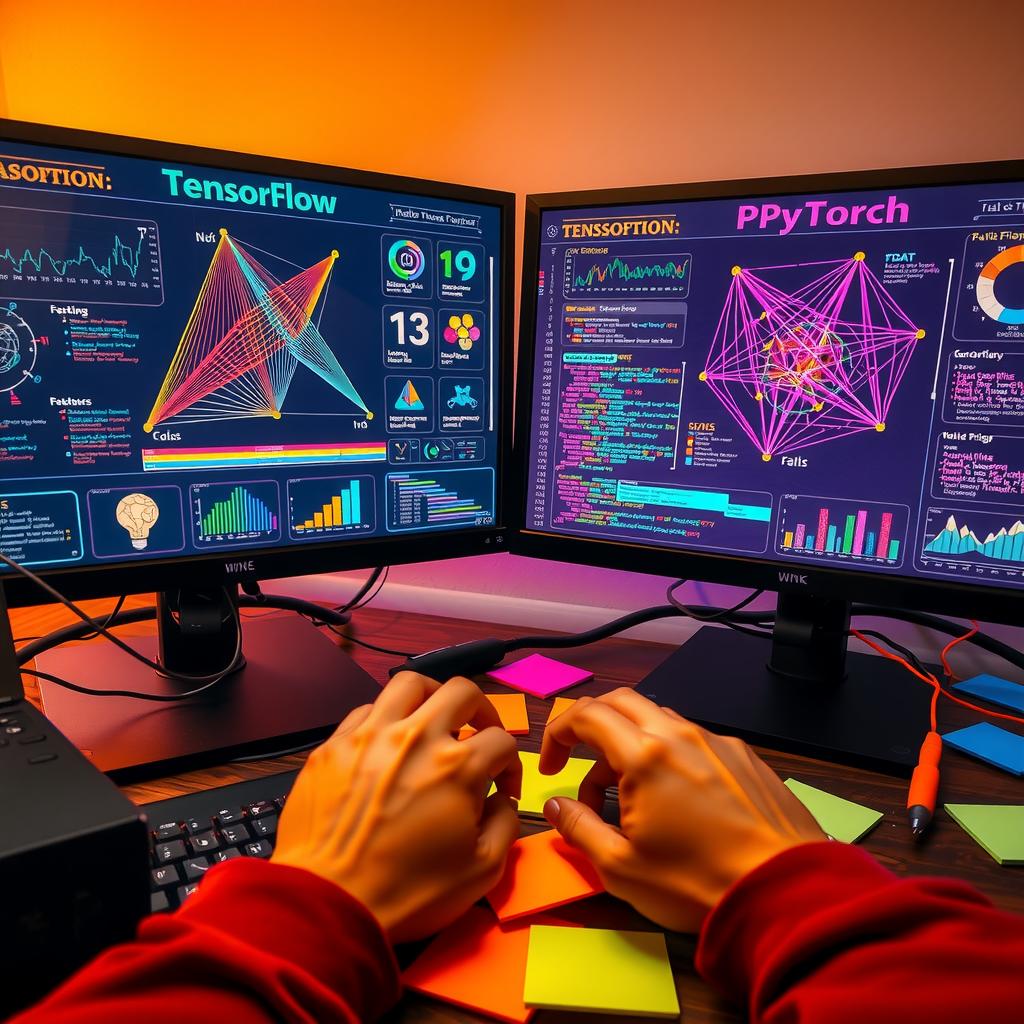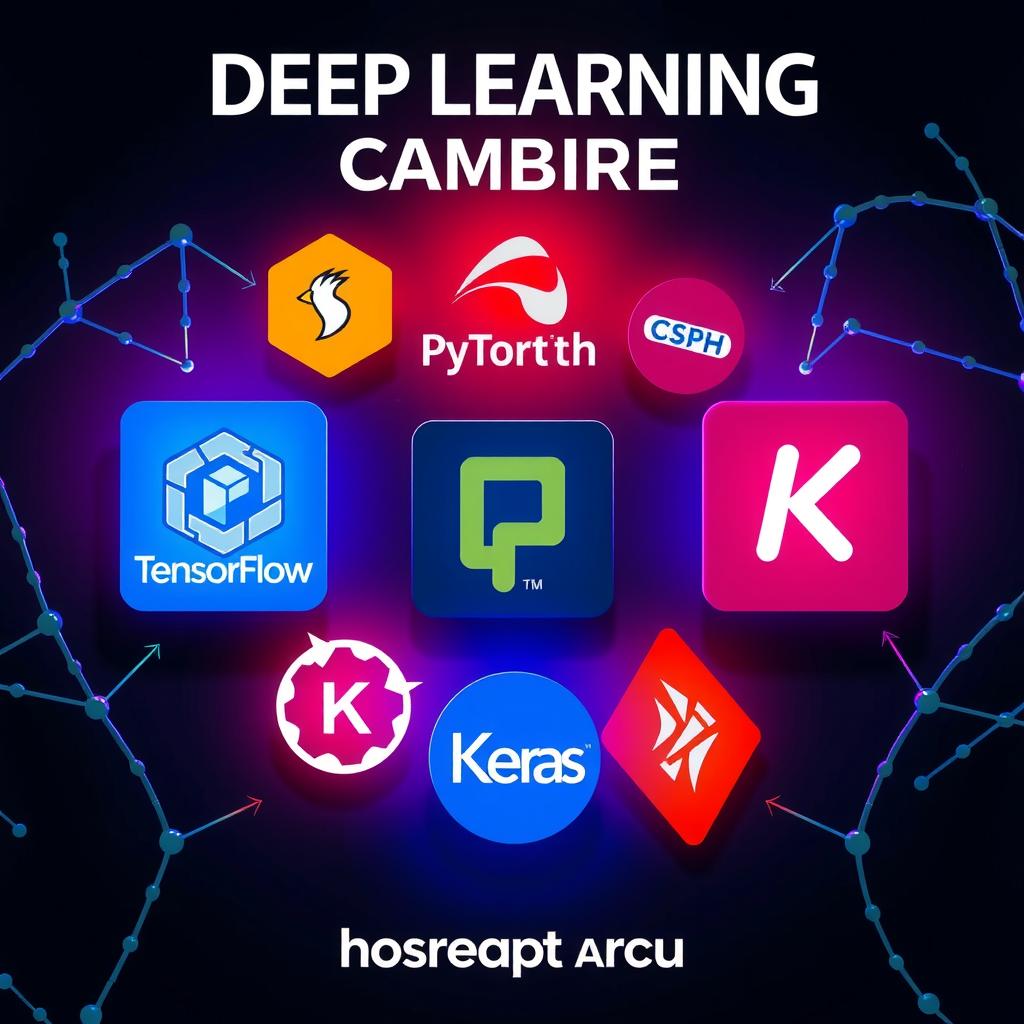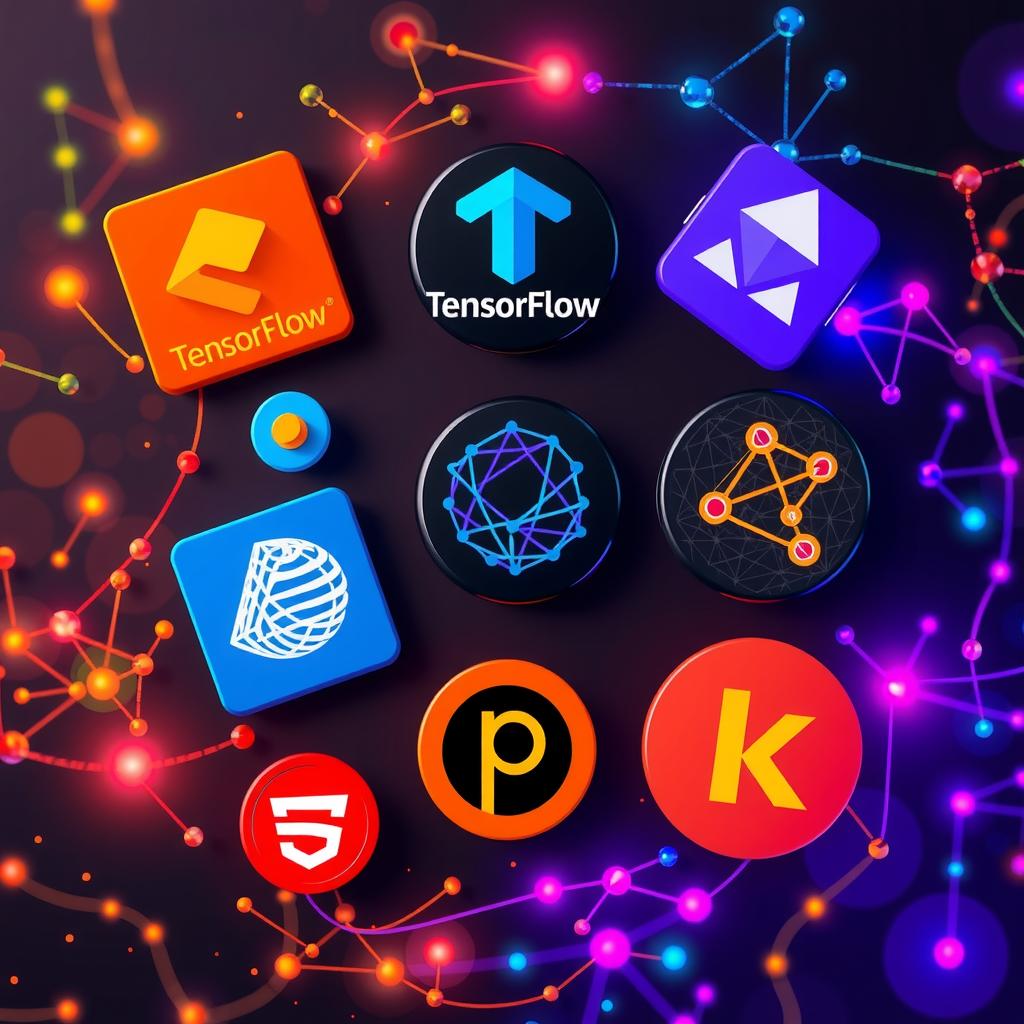In the rapidly evolving landscape of artificial intelligence and machine learning, choosing the right deep learning framework can significantly impact both productivity and performance. As of 2024, two prominent contenders in this arena are TensorFlow and PyTorch, each offering a unique set of features that cater to different needs within the data science community. While both frameworks have made notable strides in accommodating various aspects of model training, their approaches to automatic differentiation, GPU acceleration, and overall usability differ markedly. This analysis delves into these differences with an authoritative lens, providing insights for practitioners looking to make informed decisions about which framework aligns best with their project requirements.
TensorFlow is often lauded for its robust ecosystem, featuring comprehensive tools for deployment across diverse platforms. Its capabilities extend beyond mere model training; it also excels in areas such as data processing and integration with other machine learning tools. The extensive library support ensures that developers can leverage pre-built functionalities while benefiting from consistent updates driven by an active community. On the other hand, PyTorch has garnered attention for its flexibility and ease of use, particularly among researchers who require rapid prototyping capabilities without sacrificing performance evaluation standards.
The decision between using TensorFlow or *PyTorch hinges not only on technical specifications but also on individual preferences regarding workflow management and coding style. For instance, while many users appreciate how TensorFlow facilitates large-scale deployments through its graph-based architecture—which inherently supports distributed computing—others prefer PyTorch’s dynamic computation graph that allows changes during runtime. This aspect proves invaluable when experimenting with novel architectures or adjusting models based on real-time feedback.
Furthermore, community support plays a crucial role in shaping user experience around these frameworks. Both TensorFlow and PyTorch boast vast repositories of tutorials and resources designed to assist newcomers as well as seasoned experts alike—ensuring that users can find help easily when navigating challenges related to model development or optimization strategies.
As they explore the depths of each framework’s strengths—from scalability options offered by Tensorflow’s advanced deployment tools to PyTorch’s intuitive interface—the readers will gain clarity on which environment may serve their specific needs more effectively moving forward into 2024’s AI projects.

Key points:
-
Ecosystem and Community Support
The ecosystems surrounding TensorFlow and PyTorch provide developers with a wealth of resources and community support. TensorFlow boasts an extensive array of tutorials, documentation, and a vibrant community that contributes to its ongoing development. This deep learning framework is particularly favored in production environments due to its robust tools for model training and deployment. Conversely, PyTorch has gained significant traction among researchers because of its flexibility and ease of use, enabling rapid prototyping and experimentation. Both frameworks leverage strong community engagement which enhances their capabilities through shared knowledge on data processing techniques. -
Performance Evaluation Techniques
When it comes to performance evaluation, TensorFlow excels in scenarios requiring high scalability thanks to built-in features that optimize GPU acceleration. Its static computation graph allows for efficient resource utilization during model training. Meanwhile, PyTorch’s dynamic computation graph offers unparalleled flexibility that appeals to many developers looking for an intuitive experience when adjusting models on-the-fly. This distinction can significantly impact the choice between these two powerful machine learning tools depending on project requirements related to speed or adaptability. -
Automatic Differentiation Capabilities
Automatic differentiation stands as a crucial aspect when comparing TensorFlow and PyTorch in the context of deep learning dominance in 2024. While both frameworks support this vital feature efficiently, they do so through different approaches—TensorFlow utilizes symbolic differentiation via its computational graphs while PyTorch employs eager execution allowing immediate feedback during model training processes. This leads users towards choosing one over the other based on specific needs such as debugging convenience or optimization speeds, affecting overall workflow efficiency within each respective framework’s environment.

TensorFlow: The Established Powerhouse in Deep Learning
Exploring the Robust Features of TensorFlow
The landscape of deep learning frameworks has been significantly shaped by TensorFlow, a powerful tool developed by Google. As of 2024, it continues to dominate with its extensive capabilities for model training and data processing. What sets TensorFlow apart is its exceptional support for production-level deployment through tools like TensorBoard and TF Serving, which enable users to visualize their models’ performance while facilitating easy integration into existing systems. The framework boasts robust API support that caters to both beginners and experienced developers, promoting flexibility in building complex neural networks. Moreover, TensorFlow supports automatic differentiation, allowing seamless backpropagation during the training process—a critical feature for optimizing machine learning algorithms efficiently on large datasets.
A noteworthy aspect of TensorFlow’s ecosystem is its strong community backing and an abundance of resources available online. Numerous tutorials and documentation contribute to making this framework accessible even for novices venturing into deep learning. In terms of GPU acceleration capabilities, TensorFlow’s architecture allows users to leverage hardware optimally, ensuring faster computations vital for tasks such as image recognition or natural language processing. This combination makes it particularly suitable for businesses aiming to deploy scalable AI solutions effectively while maintaining high performance levels.
PyTorch: The Rising Contender
Unpacking the Flexibility and Ease-of-Use Offered by PyTorch
In contrast stands PyTorch, which has gained considerable traction among researchers and practitioners alike due to its intuitive design principles that prioritize ease-of-use without sacrificing power or efficiency. One defining characteristic of PyTorch’s appeal lies in its dynamic computation graph capability—this allows developers greater flexibility when building models as they can modify behavior on-the-fly during execution rather than relying on predefined architectures typical in other frameworks like TensorFlow. This unique trait fosters rapid experimentation essential within research environments where iterative testing is paramount.
The simplicity inherent in using PyTorch extends beyond just model creation; it also encompasses comprehensive libraries tailored towards various applications within deep learning domains including computer vision (e.g., torchvision) or natural language processing (e.g., torchtext). Furthermore, community support plays a formidable role here as well; many educational institutions have adopted PyTorch as their preferred teaching tool owing largely because students find it easier to grasp core concepts through straightforward syntax compared with alternatives such as TensorFlow,. Consequently ,the increasing availability of tutorials enhances knowledge sharing among users striving towards mastering advanced topics related not only limited solely onto model training but encompassing broader aspects encompassing data preprocessing techniques too .
Performance Evaluation: A Crucial Factor
Comparing Model Efficiency Between Tensorflow and Pytorch
When evaluating performance metrics between these two leading frameworks—Tensorflow versus Pytorch—it becomes evident that each possesses strengths catering distinctly different user needs depending upon project requirements at hand . For instance ,while previous versions were criticized over slower execution times associated primarily due static graphs used historically ; recent updates introduced eager execution mode improved overall responsiveness nearly matching real-time expectations similar seen from counterparts offered via pytorch. Additionally ,in benchmarking scenarios involving larger scale datasets utilized across various tasks performed simultaneously utilizing multiple GPUs showcased notable differences regarding memory management efficiencies obtained leveraging features exclusive either environment .
Notably however choosing one over another transcends mere numerical comparisons alone—it involves aligning specific goals set forth prior commencement alongside anticipated outcomes expected yield based upon chosen architecture employed throughout entire pipeline development stages including necessary adjustments made post initial trials conducted along way refining approach taken ultimately guiding finalization before deployment occurs . Thus understanding nuances embedded deeply entrenched within operational philosophies behind both platforms greatly influences decision-making processes undertaken addressing core challenges surrounding today’s increasingly complex demands arising out modern-day artificial intelligence initiatives amidst ever-evolving technological advancements continuously shaping industry standards observed presently affecting future trajectories yet untold ahead!

Speed Comparison: TensorFlow vs. PyTorch ### Analyzing Execution Time in Real-World Scenarios Performance metrics play a crucial role in evaluating the effectiveness of TensorFlow and PyTorch as leading deep learning frameworks. When considering execution speed, it becomes evident that both frameworks exhibit remarkable capabilities, yet they cater to different needs depending on the specific use case. For instance, TensorFlow is renowned for its ability to optimize execution through advanced graph-based computation models. This allows it to minimize latency during model training and inference phases, particularly when leveraging GPU acceleration for large-scale data processing tasks. On the other hand, PyTorch, with its dynamic computation graph system, offers immediate performance feedback which significantly enhances development speed especially beneficial during experimental stages of machine learning tools deployment. It allows researchers and developers to iterate quickly while maintaining flexibility and ease of use—an essential factor for those involved in innovative research environments or rapid prototyping scenarios.
Furthermore, real-world applications often necessitate trade-offs between raw speed and usability features such as automatic differentiation capabilities inherent within both platforms. The built-in functionalities of each framework are designed not only for performance evaluation but also provide extensive support resources including tutorials that help users navigate their respective ecosystems efficiently. Users often report faster training times with models implemented in TensorFlow, particularly when scaled across multiple GPUs or TPU systems; however, this comes at the cost of a steeper learning curve compared to PyTorch’s more intuitive approach which encourages seamless integration into existing workflows without compromising on scalability.
Scalability Analysis: How Frameworks Handle Large Datasets ### Evaluating Performance Across Varying Workloads As organizations increasingly focus on deploying scalable deep learning solutions capable of handling vast amounts of data, understanding how TensorFlow and PyTorch’s architectures accommodate scaling becomes imperative. In terms of horizontal scalability—where workload distribution across multiple nodes is essential—both frameworks demonstrate commendable efficacy; however, they employ distinct methodologies suited for diverse operational requirements.
The architecture behind TensorFlow, particularly with its distributed computing options like TF Distributed Strategy API enables robust scalability by allowing users to effectively parallelize model training over numerous machines effortlessly—a vital feature when working with massive datasets common in enterprise settings or high-stakes competitions such as Kaggle challenges where every millisecond counts towards optimizing accuracy versus time spent on model training iterations.
Conversely, while PyTorch‘s distributed capabilities have improved significantly through library updates (like Torch.distributed), some practitioners find themselves needing additional configuration steps before achieving optimal results under heavy loads—a process that might introduce complexities mainly due to its reliance on dynamic graphs rather than static ones utilized by TensorFlow. Despite these nuances affecting initial set-up times relative to community support available via forums offering insight into best practices can mitigate potential drawbacks associated with larger scale implementations using either framework.
In conclusion regarding flexibility considerations intertwined throughout discussions about scalability highlights a critical advantage offered by PyTorch: it remains highly adaptable even amidst shifting project demands thanks largely attributed towards simplicity enabling quicker adjustments required adapting strategies based upon evolving insights gained from exploratory analyses conducted earlier along data processing paths paved out earlier once initial modeling phases commence within practitioner environments prioritizing agility without sacrificing robust functionality expected from professional-grade machine learning tool suites developed around established benchmarks seen within broader AI landscape today!
Community Engagement in Framework Development
Understanding the Role of Collaboration and Resources
Community support plays a pivotal role in the growth and evolution of deep learning frameworks, particularly with prominent tools like tensorflow pytorch. The interaction between users, developers, and researchers fosters an ecosystem conducive to innovation. As community members share their experiences, challenges, and solutions through forums, tutorials, and collaborative projects, they contribute significantly to the collective knowledge base. This engagement is critical not only for performance evaluation but also for advancing model training techniques that leverage GPU acceleration efficiently. Users who actively participate can influence the direction of development by providing feedback on existing features or suggesting new functionalities that enhance flexibility and ease of use.
Moreover, available resources such as comprehensive documentation play a vital role in ensuring that both novice learners and experienced professionals can effectively utilize tensorflow pytorch in their projects. The presence of detailed tutorials allows individuals to navigate complex processes involved in data processing or automatic differentiation without extensive prior knowledge. As community-driven content proliferates across platforms such as GitHub or Stack Overflow, it becomes increasingly easier for developers to troubleshoot issues related to machine learning tools.
The future trajectory of frameworks like tensorflow pytorch will undoubtedly be influenced by how well these ecosystems harness community input alongside resource availability. Active engagement leads not only to enhancements within the framework itself but also cultivates a culture where collaboration thrives—enabling quicker iterations on ideas that push boundaries in artificial intelligence research. In this regard, organizations leveraging these tools must prioritize building robust channels for communication among users while investing time into curating high-quality educational materials.
In conclusion, understanding the intricate relationship between community support and ecosystem growth reveals essential insights into developing effective machine learning solutions using frameworks like tensorflow pytorch. By fostering an environment rich with accessible resources coupled with active user participation across various levels—from beginner tutorials to advanced optimization strategies—these technologies are better positioned for future advancements driven by collective ingenuity.
In 2024, the competition between TensorFlow and PyTorch continues to intensify, as both deep learning frameworks evolve to meet the needs of researchers and developers. One key area where they differ is in their flexibility and ease of use. TensorFlow, with its static computation graph approach, often appeals to those who require optimized performance for production scenarios. This makes it a preferred choice for large-scale model training and deployment. On the other hand, PyTorch has gained immense popularity for its dynamic computation graph feature, allowing developers to write more intuitive code that facilitates rapid prototyping and experimentation in machine learning tools.
Another significant aspect is community support, which plays a crucial role in the usability of any deep learning framework. While both TensorFlow and PyTorch boast strong communities that contribute extensive tutorials and resources, some users find that the vibrant ecosystem surrounding PyTorch offers superior accessibility when it comes to practical applications in research settings. The vast array of libraries built on top of these frameworks further enhances their capabilities; however, many practitioners gravitate towards _PyTorch’s automatic differentiation capabilities, which simplify gradient calculations during backpropagation.
Performance evaluation remains critical as organizations aim to optimize their models effectively. Both frameworks provide robust GPU acceleration options tailored for high-performance computing tasks involving data processing at scale. While traditional benchmarks indicated that *TensorFlow’s optimizations could result in faster execution times overall under certain conditions, recent developments have shown that well-optimized models trained using either framework can yield comparable results depending on specific use cases.
Common Queries:
Q: What are the main differences between TensorFlow and PyTorch?
A: The primary differences lie in their programming paradigms; TensorFlow uses static graphs while PyTorch employs dynamic graphs which allow greater flexibility during model training.
Q: Which framework is better suited for beginners?
A: Many newcomers find PyTorch easier due to its straightforward syntax and immediate feedback loop from dynamic computations compared to TensorFlow’s more complex setup requirements initially.
Q: How do community contributions impact TensorFlow vs PyTorch?
A: Community contributions significantly enhance both frameworks; however, many users feel that PyTorch’s active user base provides richer resources such as tutorials compared with those available for TensorFlow.




